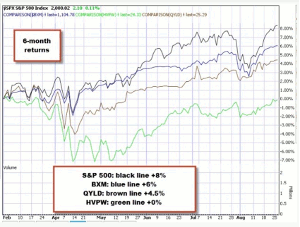Alan Ellman of TheBlueCollarInvestor.com addresses the popular new ETFs that are based on covered call writing and put-selling strategies, why they underperform the overall market and how retail investors and options traders can do much better on their own.
With the popularity of covered call writing and selling cash-secured puts growing in popularity, we have witnessed the creation of new exchange traded funds based on these strategies. Over the last few years, I have not been a proponent of these securities mainly because they underperform the overall market and motivated retail investors can do so much better on their own. In today’s article, I will examine two of the newer covered call and put-selling ETFs, QYLD and HVPW. First, some explanations of the ETFs to be evaluated and the benchmarks we will use for comparison:
Benchmarks:
The CBOE S&P 500 BuyWrite Index
The CBOE S&P 500 BuyWrite Index (BXM) is a benchmark index designed to track the performance of a hypothetical buy-write strategy on the S&P 500 Index. The BXM is a passive total return index based on:
- Buying an S&P 500 stock index portfolio, and
- Writing (or selling) the near-term S&P 500 covered call option, generally on the third Friday of each month. The S&P 500 call written will have about one month remaining to expiration, with an exercise price just above the prevailing index level (i.e., slightly out-of-the-money). The S&P 500 call is held until expiration and cash settled, at which time a new one-month, slightly out-of-the-money call is written.
S&P 500
An index of 500 stocks chosen for market size, liquidity, and industry grouping, among other factors. The S&P 500 (SPX) is designed to be a leading indicator of US equities and is meant to reflect the risk/return characteristics of the large-cap universe. It is generally considered a reliable reflection of the overall stock market or its benchmark.
ETFs:
The Recon Capital NASDAQ 100 Covered Call ETF
The Recon Capital NASDAQ 100 Covered Call ETF (QYLD) is the only ETF that utilizes a buy-write strategy based on the NASDAQ 100. It seeks to provide investment results that will closely correspond, before fees and expenses, generally to the price and yield performance of the CBOE NASDAQ-100® BuyWrite Index (BXN). It is a passive total return index based on:
- Buying a NASDAQ-100 stock index portfolio, and
- Writing (or selling) the near-term NASDAQ-100 Index (NDX) covered call option, generally on the third Friday of each month. The NASDAQ-100 Index call written will have about one month remaining to expiration, with an exercise price just above the prevailing index level (i.e., slightly out-of-the-money). The NASDAQ-100 Index call is held until expiration and cash settled, at which time a new one-month, slightly out-of-the-money call is written.
ALPS US Equity High Volatility Put Write Fund
The ALPS US Equity High Volatility Put Write Fund (HVPW) is an income-generating fund that creates income by selling 2-month 15% out-of-the-money puts (lower than current market value) on 20 diversified stocks with high implied volatility. The fund is fully collateralized by short-term 3-month T-bills.
Next, let’s set up a chart showing the returns of the two benchmarks and the two ETFs over a six-month time frame:

Covered call writing and put-selling ETFs vs market benchmarks
Click to Enlarge
NEXT PAGE: The Other Major Issues of the ETFs
|pagebreak|Why These ETFs Underperform
During this time frame, both ETFs under-performed both benchmarks significantly. Let’s examine some of the reasons for these lower returns:
Fees and expenses
We would expect the costs to participate in the ETFs to result in a return of least 1% lower than the benchmarks.
Selection of the underlying securities
In the case of QYLD, all 100 stocks from the Nasdaq 100 are included in the portfolio. If we were to develop our own portfolio, we could select only the best-performers from this group and the ones that generated the returns that met our goals rather than accepting all securities simply because they were members of this index. For HVPW, high volatility stocks are stresses, which may or may not be appropriate to maximum strategy results as an additional layer of risk is introduced.
Only out-of-the-money strikes utilized
Slightly out-of-the-money strikes are great because they allow us to generate two income streams in the same month with the same stock and cash: one from option profit and the other from share appreciation up to an out-of-the-money strike. However, there are times when an in-the-money call strike is more appropriate or a deeper out-of-the-money put may be a better choice. I am referring to bear or volatile market conditions which may dictate a more conservative approach to covered call writing or put-selling to afford us more downside protection. Similarly, in a raging bull market, we may want to utilize a deeper out-of-the-money call option or an in-the-money put option to generate even higher returns. The main point here is that having more strategy flexibility will allow retail investors to generate much higher returns than a rigidly-structured ETF.
No position management strategies
Eliminating the use of exit strategy opportunities and position management techniques is a major flaw with these ETFs when comparing the strategies to how we, as retail investors, can manage them. We can take action to enhance profits to even higher levels when share price increases and also take action to mitigate losses when share prices declines.
Summary
Covered call writing and put-selling ETFs allow us to participate in low-risk option strategies without having to take the time and effort to learn and manage the strategies ourselves. However, because of fees, expenses, lack of strategy flexibility, and no position management components, the results will far underperform both the market benchmarks and the even higher returns that can be achieved by elite covered call and put-writers.
By Alan Ellman of TheBlueCollarInvestor.com










